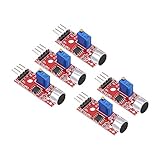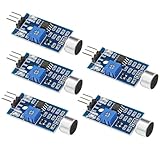The Best Arduino Microphone of 2022 – Reviewed and Top Rated
After hours researching and comparing all models on the market, we find out the Best Arduino Microphone of 2022. Check our ranking below.
2,540 Reviews Scanned
- Application: MAX4466 microphone breakout is suitable for voice converters, audio recording and sampling, and audio response projects using FFT; On the back, there is a small trimmer pot to adjust the gain; You can set the gain from 25x to 125x
- Parameters: power supply voltage: +2.4V to +5.5V (can be compatible with STM, Raspberry Pi and other development board motherboards); Power supply rejection ratio: 112dB; Common mode rejection ratio: 126dB; AVOL: 125dB (RL = 100kΩ) rail-to-rail output; Quiescent power supply current: <24μA; Gain bandwidth: 600kHz
- 20-20KHz electret microphone soldered on: comes with a 20-20KHz electret microphone soldered on the board for audio-reactive projects; It is recommended to use the FFT driver library, which can take audio input and 'translate' it into frequencies
- Easy to use: connect GND to ground, VCC to 2.4-5VDC; For the good performance, use the 'quietest' supply available (this would be the 3.3V supply)
- Power supply noise rejection function: the amplifier has good power supply noise rejection
- MAX4466 Sound Sensor: Realize sound detection, analysis and recognition, and effectively amplify and preprocess weak sound signals so that subsequent algorithms can extract and analyze sound features
- Supply voltage: 2.4 - 5.5V
- Static supply current: 24μA
- Gain bandwidth: 600kHz
- Widely used in music playback, speech recognition, voice communication and other fields, it can improve the sensitivity and sound quality of the audio system
- The module has 2 outputs: AO, analog output, real-time output microphone voltage signal; DO, when the sound intensity reaches a certain threshold, it outputs high and low level signals, [threshold-sensitivity can be adjusted by potentiometer]
- There are 3mm mounting screw holes, which are powered by a 5v DC power supply.
- There is an analog output with a threshold flip level output.
- High sensitivity microphone with high sensitivity.
- There is a power indicator and the comparator output has an indicator.
- INMP441 is a high-performance, low-power, digital output, omnidirectional MEMS microphone with a bottom port
- The INMP441 module includes MEMS sensors, signal composition adjustment, analog-to-digital converters, anti-aliasing filters, power management, and an industry-standard 24-bit I2S interface
- The I2S interface allows INMP441 to be directly connected to digital processors, such as DSPs and microcontrollers, without the need for audio codecs used in the system
- The INMP441 has a high signal-to-noise ratio of 61dBA, making it an excellent choice for near-field applications
- INMP441 has a flat broadband frequency response, resulting in high sound clarity
- This sound module can detect sound strength of the environment
- Working Voltage: DC 3.3V-5.5V; Sensitivity adjustable
- Output form: Digital and Analog Output
- High sensitive microphone sensor
- Good for learning basic knowledge about Arduino and sensors
- The board comes with a 20-20KHz electret microphone soldered on
- Using the MAX4466, an op-amp specifically designed for amplifier
- For the best performance, use the "quietest" supply available (on an for Arduino, this would be the 3.3V supply)
- The amplifier has excellent power supply noise rejection
- This breakout board is best used for projects such as voice changers, audio recordingmpling, and audio-reactive projects that use FFT
- Working voltage 3.3V-5V;Adjustable sensitivity (adjusted by the blue digital potentiometer in the picture);Output form Digital switch output (0 and 1 high and low levels);Equipped with fixing bolt holes for easy installation; Small board PCB size: 32mm * 17mm
- The sound module is most sensitive to the intensity of ambient sound and is generally used to detect the intensity of ambient sound.
- When the ambient sound intensity does not reach the set threshold, the module OUT outputs a high level. When the ambient sound intensity exceeds the set threshold, the module OUT outputs a low level;
- The digital output OUT of the small board can be directly connected to the microcontroller, and the high and low levels can be detected by the microcontroller to detect the ambient sound;The digital output OUT of the small board can directly drive the relay module, thereby forming a voice-controlled switch;
- VCC is connected to an external 3.3V-5V voltage (can be directly connected to a 5V microcontroller and a 3.3V microcontroller); GND is connected to an external GND; OUT is the small board switch output interface (0 and 1).
- Diameter: 9mm/ 0.35inches
- Length: 7mm/ 0.28inches
- Sensitivity: -48-66dB
- Frequency Range: 50 20KHz
- Current Consumption: Max 500uA
- ★Microphone Sensor High Sensitivity Sound Detection Modules for A-rduino PIC AVR
- ★Uses 5V DC power supply
- ★Has 3mm mounting screw hole
- ★Has two outputs: AO, analog output, real-time output voltage signal of the microphone
- ★Package Includes:3pcs Microphone Sensor High Sensitivity Sound Detection Module
- Sound Sensor:Detecting the presence and absence of sound via a microphone (vibration principle)
- Operating voltage 3.3V-5V
- Adjustable Threshold: Built-in potentiometer to adjust detection intensity
- Compatible with for Arduino AVR ARM PIC and other platforms
Last update on 2025-09-21 / Affiliate links / Images from Amazon Product Advertising API
How Do You Buy The Best Arduino Microphone?
Do you get stressed out thinking about shopping for a great Arduino Microphone? Do doubts keep creeping into your mind? We understand, because we’ve already gone through the whole process of researching Arduino Microphone, which is why we have assembled a comprehensive list of the greatest Arduino Microphone available in the current market. We’ve also come up with a list of questions that you probably have yourself.
We’ve done the best we can with our thoughts and recommendations, but it’s still crucial that you do thorough research on your own for Arduino Microphone that you consider buying. Your questions might include the following:
- Is it worth buying an Arduino Microphone?
- What benefits are there with buying an Arduino Microphone?
- What factors deserve consideration when shopping for an effective Arduino Microphone?
- Why is it crucial to invest in any Arduino Microphone, much less the best one?
- Which Arduino Microphone are good in the current market?
- Where can you find information like this about Arduino Microphone?
We’re convinced that you likely have far more questions than just these regarding Arduino Microphone, and the only real way to satisfy your need for knowledge is to get information from as many reputable online sources as you possibly can.
Potential sources can include buying guides for Arduino Microphone, rating websites, word-of-mouth testimonials, online forums, and product reviews. Thorough and mindful research is crucial to making sure you get your hands on the best-possible Arduino Microphone. Make sure that you are only using trustworthy and credible websites and sources.
We provide an Arduino Microphone buying guide, and the information is totally objective and authentic. We employ both AI and big data in proofreading the collected information. How did we create this buying guide? We did it using a custom-created selection of algorithms that lets us manifest a top-10 list of the best available Arduino Microphone currently available on the market.
This technology we use to assemble our list depends on a variety of factors, including but not limited to the following:
- Brand Value: Every brand of Arduino Microphone has a value all its own. Most brands offer some sort of unique selling proposition that’s supposed to bring something different to the table than their competitors.
- Features: What bells and whistles matter for an Arduino Microphone?
- Specifications: How powerful they are can be measured.
- Product Value: This simply is how much bang for the buck you get from your Arduino Microphone.
- Customer Ratings: Number ratings grade Arduino Microphone objectively.
- Customer Reviews: Closely related to ratings, these paragraphs give you first-hand and detailed information from real-world users about their Arduino Microphone.
- Product Quality: You don’t always get what you pay for with an Arduino Microphone, sometimes less, and sometimes more.
- Product Reliability: How sturdy and durable an Arduino Microphone is should be an indication of how long it will work out for you.
We always remember that maintaining Arduino Microphone information to stay current is a top priority, which is why we are constantly updating our websites. Learn more about us using online sources.
If you think that anything we present here regarding Arduino Microphone is irrelevant, incorrect, misleading, or erroneous, then please let us know promptly! We’re here for you all the time. Contact us here. Or You can read more about us to see our vision.
FAQ:
Q: Is Arduino able to handle a microphone?
A: Basically, any circuit that needs to be triggered by sound can be done with a microphone as input into an arduino. How this circuit works is through the use of a microphone. We will use a microphone to be able to detect sound. But a microphone alone is insufficient for this circuit.
Q: Is the Arduino a microcontroller?
A: Arduino is a single-board microcontroller, intended to make the application of interactive objects or environments more accessible. [1] The hardware consists of an open-source hardware board designed around an 8-bit Atmel AVR microcontroller, or a 32-bit Atmel ARM.
Q: Can communication with Arduino?
A: Introduction. It is possible to chain Arduinos together in such a way as to get communication between the two. Having Arduino-Arduino communication can be useful for many projects, such as having one Arduino to run motors and having another sense the surroundings and then relay commands to the other Arduino.
Q: What is micro Arduino?
A: The Arduino Micro is essentially a shrunk-down (1.9″ × 0.7″) version of the Arduino Leonardo: it is a microcontroller board based on the ATmega32U4 running at 16 MHz with 24 digital input/output pins (of which 7 can be used as PWM outputs and 12 as analog inputs).
Related Post:
- Arduino Microphone Amplifier
- Spectrum Microphone Stand With Bonus Microphone
- Arduino Nano Shield I/O Extension Board Expansion Xd-212
- Sainsmart L293D Motor Drive Shield For Arduino Duemilanove Mega Uno R3 Avr Atmel
- Cheap Arduino Kits
- Buy Arduino Due
- Arduino Due Price
- Cheap Arduino Kit
- Sunfounder Iic I2C Twi Serial 2004 20X4 Lcd Module Shield For Arduino Uno Mega2560
- Arduino Yun Buy









